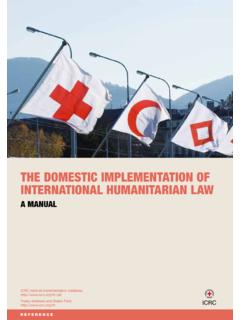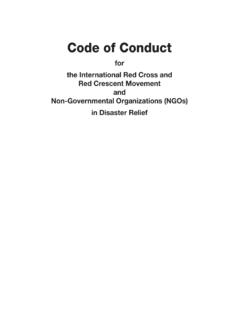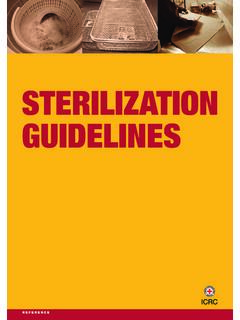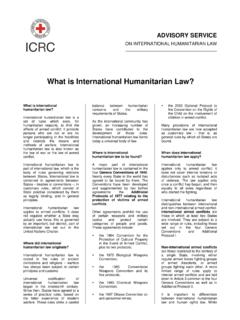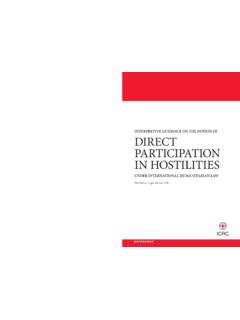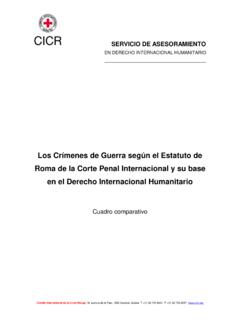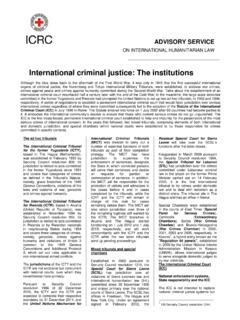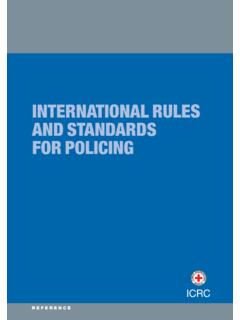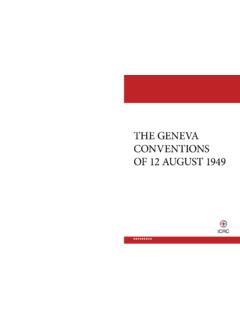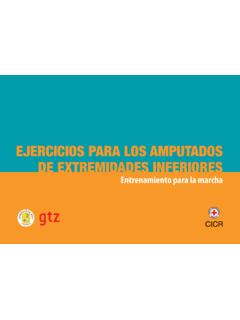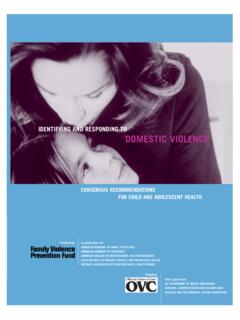Transcription of Domestic regulation of international humanitarian relief ...
1 Volume 89 Number 866 June 2007. Domestic regulation of international humanitarian relief in disasters and armed conflict: a comparative analysis David Fisher*. David Fisher is the Senior Legal Research Officer for the international Federation of Red Cross and Red Cross Societies' international Disaster Response Laws, Rules and Principles (IDRL) Programme. Abstract In both disasters and armed conflicts, Domestic regulatory control over the entry and operation of international humanitarian relief operations can significantly affect their ability to address the critical needs of affected persons. The types of regulatory problems that arise, such as customs barriers, visa issues and taxation of aid, are often similar, but both the underlying dynamics and the applicable international law can be quite different.
2 This article analyses these similarities and differences and suggests distinct steps that might be taken to move forward in the two contexts. In the wake of a major disaster or an armed conflict,1 the lives and dignity of affected persons may depend on international humanitarian relief . In both contexts, the regulatory approach taken by Domestic authorities can enhance the ability of international humanitarian actors to provide this relief in a timely and effective manner. Too often, however, it has just the opposite effect. * The views and opinions expressed in this article are the author's and do not necessarily represent those of the international Federation or its member societies.
3 Elements of this article were drawn from a larger study of IDRL currently being prepared by the international Federation. 345. D. Fisher Domestic regulation of international humanitarian relief in disasters and armed conflict: a comparative analysis This paper will take a comparative look at the common regulatory problems and the applicable international law for relief in armed conflicts and non-conflict disasters. It will argue that many of the problems are similar. These include both regulatory barriers, such as bureaucratic delays in the entry of personnel, goods and equipment, as well as regulatory gaps, for instance, with regard to mechanisms speedily to provide Domestic legal recognition of international relief organizations.
4 In both disasters and conflicts, the ability and willingness of Domestic authorities to address these problems are impacted by factors including the distraction and reduced administrative capacity stemming from their own efforts to respond to the emergency, the unique need for speed inherent in humanitarian operations and, in particularly high-visibility emergen- cies, the increasingly large and diverse community of international actors who seek to intervene. Yet there are also substantial differences. In armed conflicts, security is an overwhelming concern from several points of view. Armed parties who worry that international relief will favour their enemies. humanitarian actors who fear for the safety of their staff and material.
5 Meanwhile affected persons, who must be as concerned about being attacked as meeting their basic needs. Also, particularly in internal armed conflicts (currently the predominant form of warfare), there is frequently more than one de facto authority exercising regulatory power over international humanitarian relief efforts. These factors lead to more deliberate barriers than are commonly found in disaster settings. On the other hand, in disasters there is an expectation (sometimes unfulfilled) that Domestic authorities will take the primary role in humanitarian aid efforts and not only facilitate the access of international humanitarian aid where needed, but also co-ordinate it and monitor its effectiveness.
6 In armed conflict the expectations are quite different, due to the status of the Domestic authorities as parties to the conflict. There are also important differences in the character and content of the applicable international law. For disasters, the relevant norms are scattered among instruments from different sectors with varying degrees of specificity and geographic reach, providing at best incomplete guidance. In contrast, in armed conflict international humanitarian law has much broader acceptance and scope and provides for some very specific rights and obligations. However, even in international humanitarian law, there are ambiguities about the extent of the obligations of Domestic actors to consent to and facilitate international relief , particularly in internal armed conflicts.
7 What is clear is that there are substantially fewer conditions that may legitimately be imposed on international humanitarian organizations before allowing them access in conflict settings than in disasters. This paper will suggest that progress ought to be possible across the board on solving the common regulatory problems in both disasters and conflicts. However, there are also strong reasons to take distinct steps toward this goal in the 1 For the purposes of this article the term disaster'' will be considered not to include armed conflicts. 346. Volume 89 Number 866 June 2007. two contexts, because of both their differing dynamics and the specific requirements of international humanitarian law.
8 General obligations to allow and facilitate international humanitarian relief Before turning to the individual regulatory issues, it is helpful briefly to recall what international law provides in general concerning the obligations of Domestic authorities to allow and facilitate humanitarian assistance. The relevant norms can be found in the domains of human rights (applicable to both conflicts and disasters), international humanitarian law (applicable only to conflicts), refugee and internally displaced person (IDP) law (which may or may not be applicable in a particular conflict or disaster setting), and an other'' category, increasingly known as international disaster response laws, rules and principles'' (IDRL) (with primary application to disasters).
9 Human rights law With a few notable exceptions,2 the major human rights instruments do not directly refer to international humanitarian relief . Some scholars have asserted, therefore, that there is no general right to receive such However, existing human rights instruments do set out a great many related rights, such as the rights to life,4 food,5 housing,6 clothing,7 health,8 and These rights have been 2 See the discussion below concerning references to refugee and displaced children in the Convention on the Rights of the Children and the African Charter on the Rights and Welfare of the Child. There are also a number of references to international relief in expert-produced soft-law'' documents.
10 See, , Council of the international Institute of humanitarian Law, Guiding Principles on the Right to humanitarian Assistance (April 1993); Institute of international Law, Resolution of the Institute of international Law on humanitarian Assistance (Bruges Session 2003), Article II(2); Resolution of the Institute of international Law on the Protection of Human Right and the Principle of Non-Intervention in Internal Affairs of States (Santiago de Compestela Session 1989), Article 5, as well as the Guiding Principles on Internal Displacement, also discussed below. 3 See, , Yoram Dinstein, The right to humanitarian assistance in peacetime'', Naval War College Review, Vol. 53 (Autumn 2000), p.
